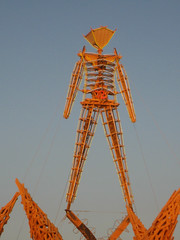The Truth About Burning Man

The Truth About Burning Man: Jay Michaelson admits he doesn't have it!
"Really?" the guy at the Alamo Rental Car place said, when I'd told him about Burning Man. "I heard it was just a lot of naked people running around on drugs."
Coated in gypsum dust, and still high not on drugs but on the altered consciousness of radical creativity and community, I had just tried to describe what Burning Man is, somehow. I think I'd said something like, "It's a temporary city of 50,000 people, devoted to radical self-expression. So you'll find anything you'd find in a regular city -- art museums, dance clubs, yoga studios -- only in the middle of the desert, with no money, and with more creativity than you've ever seen."
Of the two descriptions, surely Rental Car Guy's is the more familiar. When Adam Lambert revealed that he'd gotten the idea to go on American Idol while on mushrooms at Burning Man, America groaned. The image, I assume, was of a drugged-out weirdo coming up with a loopy idea in the middle of wild, crazy party.
The truth, though, is that Burning Man is an ideal place for self-reflection and self-transformation, whether substance-aided or not, and as someone who's just gotten back from his 8th Burn, Lambert's revelation didn't surprise me a bit. Friends of mine have changed their names, their professions, and their entire lives at Burning Man. And not because they were stoned or tripping, but because Black Rock City -- the temporary city (built and erased within a month) where the event goes on every year, the week before Labor Day -- has a tendency to expand horizons, reveal possibilities, and question the assumptions most of us make about how we're supposed to live our lives.
Burning Man does this, I think, because of a combination of factors. One of them is the sheer size and scope of the thing. 50,000 people. Hundreds of cars and trucks modified to look like dragons, whales, radios, and steamboats; many breathing fire; most with dozens of revelers dancing on them. It's like "Mad Max" meets "Blade Runner" meets "The Ten Commandments," and it's real, it's actually happening.
[...]
You don't get it. You don't get what it's like to have 50,000 people circle around a wooden effigy, with 1000 people spinning fire and 500 more playing drums, all encircled by 200 art cars -- and then all roaring in unison as the effigy is set afire. You might think you get it, and it may scare or tempt or delight you, but I assure you, you don't get it. None of us do, because it's not about any one thing in particular; "it" can be an orgiastic celebration, or the sad mourning of a lost loved one. Or a warm, hippie-like community. Or a mean, Mad-Max-like apocalypse. "It" is chiefly a space in which all these things are possible.
The temporary erasure of societal, social, and personal boundaries is, for most of us, terrifying. Such boundaries help build the structures of society and self; they give form to human life, which is often chaotic and unpredictable. Thus they have been the bedrock of religious and civil life for millennia, even before the Furies were imprisoned under Athens, and Moses descended from Sinai.
But if religion creates boundaries, mysticism and spirituality efface them. In the transcendence of ordinary distinctions, peak experiences such as those encouraged at Burning Man give a glimpse of the ultimate, the infinite. It may seem absurd to suggest that Burning Man is a mystical event. But then, if it's just a big party, why is there a temple in the middle of it?


0 Comments:
Post a Comment
<< Home